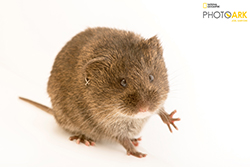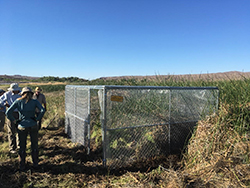
A tagged Amargosa vole. (National Geographic stock photo)

The “soft release structures” built for the voles were constructed in their natural habitat, giving the captive-bred animals time to adjust to the outdoors. (Photo courtesy of UC Davis School of Veterinary Medicine)
Wildlife veterinarians recently hit an important milestone in their collective efforts to conserve a tiny endangered mammal native to the Mojave Desert. The population of Amargosa voles (Microtus californicus scirpensis), restricted to one small town in Inyo County, is now perilously small, due to habitat destruction, climate change and water diversions created to benefit humans. With much of the voles’ natural habitat now decimated, scientists estimate that fewer than 500 currently exist in the wild. (Read the original California Department of Fish and Wildlife Science Spotlight on Amargosa voles).
Co-led by CDFW Wildlife Veterinarian Dr. Deana Clifford and UC Davis Veterinarian Dr. Janet Foley, the Amargosa vole recovery program started in 2012. After the population became nearly extinct in 2014, a captive breeding program was launched at the UC Davis School of Veterinary Medicine as a last-ditch effort to save these tiny creatures, which are a key link in the food chain in their native habitat.
Since the breeding program’s inception, 364 voles have been born and weaned. Several small-scale trial releases have been attempted over the last few years, leading the scientists to identify a clear problem: the animals raised in captivity didn’t necessarily know how to behave in the wild. “The colony animals were a little pampered,” said Foley, referring to the first few trial releases. “They didn’t seem to have the skills to thrive on their own.”
So how to teach a pampered vole to fend for itself? The team members tried several approaches, finally solving an important piece of the puzzle last month. The key was to introduce captive-bred animals to their wild counterparts – and let the former learn from the latter.
The team chose to pair six captive males from the facility at UC Davis with six wild caught females. The voles were introduced to each other for 10 days in temporary indoor cages in Shoshone Village to see which pairs appeared compatible for mating.
Once voles had established pairs, they were moved outdoors. Large dog runs were carefully constructed in their marshland, over the native bulrush that provide shelter and food for the voles. Each run was lined with hardware cloth in order to contain the voles and keep out predators (including coyotes, bobcats, snakes, numerous bird species, bullfrogs, house cats and stray dogs).
For the next 21 days, the new vole pairs continued to get to know each other. Project staff used pit tags – basically telemetry microchips – to monitor their movements and to ensure that they were thriving.
“We used an antenna array around the feeding station, which connects to a computer, so we could watch how they move,” Foley explained. “Most of the time they’re under the bulrush so you can’t see them with the naked eye … but we were amused to see that they’re really not that shy. One male built a tunnel in his natural habitat, but when staff was nearby, he would come out and look right at us before he grabbed food and went back in.”
At the end of 21 days, the kennel doors were opened, allowing the voles to venture out on their own. Foley says that the team was somewhat surprised to see that the pairs generally continued to come and go from the kennels, demonstrating a comfort level with the makeshift shelter. More importantly, at least one of the pairs produced a litter, and several of the other females may be pregnant.
At some point, the team will remove the kennels entirely, at least until the next captive release occurs, likely sometime next spring or summer.
Foley said that she views the July release as a rousing success – not just because the animals are thriving, but because of the body of knowledge the team learned from this experience. “It was really important for us to learn that the colony animals could learn survival skills from their wild counterparts,” she explained. “It was a gamble, and the fact that it worked is so exciting.”
The team will continue to use this technique for the foreseeable future. Ultimately, the goal is to create sustainable populations of Amargosa voles in several different areas. “If there’s a big fire, it could wipe out every marsh in the area,” Foley says. “Our work – and the techniques we are working to perfect -- will help ensure their survival.”
The captive breeding program is one part of a larger joint effort between agencies, universities and nonprofits to save the Amargosa vole. “Together with our partners at the US Fish and Wildlife Service, BLM, UC Davis and UC Berkeley, Shoshone Village and the Amargosa Conservancy, we are conducting habitat restoration, translocations, genetics and health monitoring and community engagement,” Clifford added. “What we’ve learned here not only helps voles, but also helps conserve the other species that rely on these fragile desert marshes.”
Photos Copyright UC Davis School of Veterinary Medicine. Top Photo: One of the recovery team staff members monitoring the vole’s outdoor enclosure during the introductory period. (Photo Courtesy of UC Davis School of Veterinary Medicine)
Media contacts:
Kirsten Macintyre, CDFW Communications, (916) 322-8988
Trina Wood, UC Davis Communications, (530) 752-5257